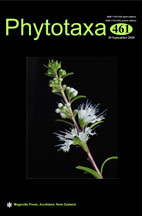Abstract
Diaporthe taiwanensis sp. nov. (Diaporthales, Sordariomycetes, Ascomycota) isolated on living leaves of Ixora chinensis from Taiwan, is characterized using both phenotypic and genetic characters. Phylogenetic reconstructions based on concatenated DNA sequence data of four nuclear genetic markers (ITS, tef1-α, β-tubulin and cal) show that the new taxon is separated from other representative species of Diaporthe with high statistical support. The new taxon differs from its phylogenetically related congeners mainly by having larger alpha conidia and producing beta conidia in culture and further by host and geographical distribution. Artificial inoculation on leaves confirmed the pathogenicity of the novel fungus to Ixora. The present study is the first report of Diaporthe species causing leaf spots and necrosis on Ixora chinensis in Taiwan.

